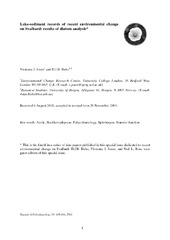Lake-sediment records of recent environmental change on Svalbard: results of diatom analysis
Peer reviewed, Journal article
Permanent lenke
https://hdl.handle.net/1956/2474Utgivelsesdato
2004Metadata
Vis full innførselSamlinger
Originalversjon
https://doi.org/10.1023/b:jopl.0000022544.35526.11Sammendrag
Surface sediments from 23 lakes on Svalbard were analysed for diatoms. 182 taxa were found but samples generally have a low richness, with the majority of sites dominated by benthic genera such as Fragilaria, Navicula, and Achnanthes. Centric Cyclotella species occur at only three sites. Modern relationships between diatom abundance and water chemistry and other environmental variables were explored numerically and a preliminary transfer function for pH was developed. Lakes fell into three groups on the basis of their diatom assemblages: (1) high pH, high cation, high conductivity sites characterised by Amphora libyca, (2) shallow sites with relatively high nutrient values characterised by Fragilaria species, and (3) more acid and dilute sites with high amounts of snow cover in the catchments characterised by small Achnanthes species and Navicula digitulus. Five sediment cores representing the recent past were also analysed for diatoms. Three shallow sites were dominated by Fragilaria species throughout the period represented by the cores and no shifts in inferred pH were found. At two deeper sites (Arresjøen, Birgervatnet) major assemblage shifts are found which are unrelated to independent evidence for atmospheric contamination. Early (ca. 1200 AD) changes found at both sites are possibly related to the onset of the ‘Little Ice Age’. Later changes are neither synchronous nor similar in nature and might be best explained as individual responses to the recovery from the ‘Little Ice Age’ and subsequent climatic warming.
Beskrivelse
This is the fourth in a series of nine papers published in this special issue dedicated to recent environmental change on Svalbard. H.J.B. Birks, Vivienne J. Jones, and Neil L. Rose were guest editors of this special issue.
